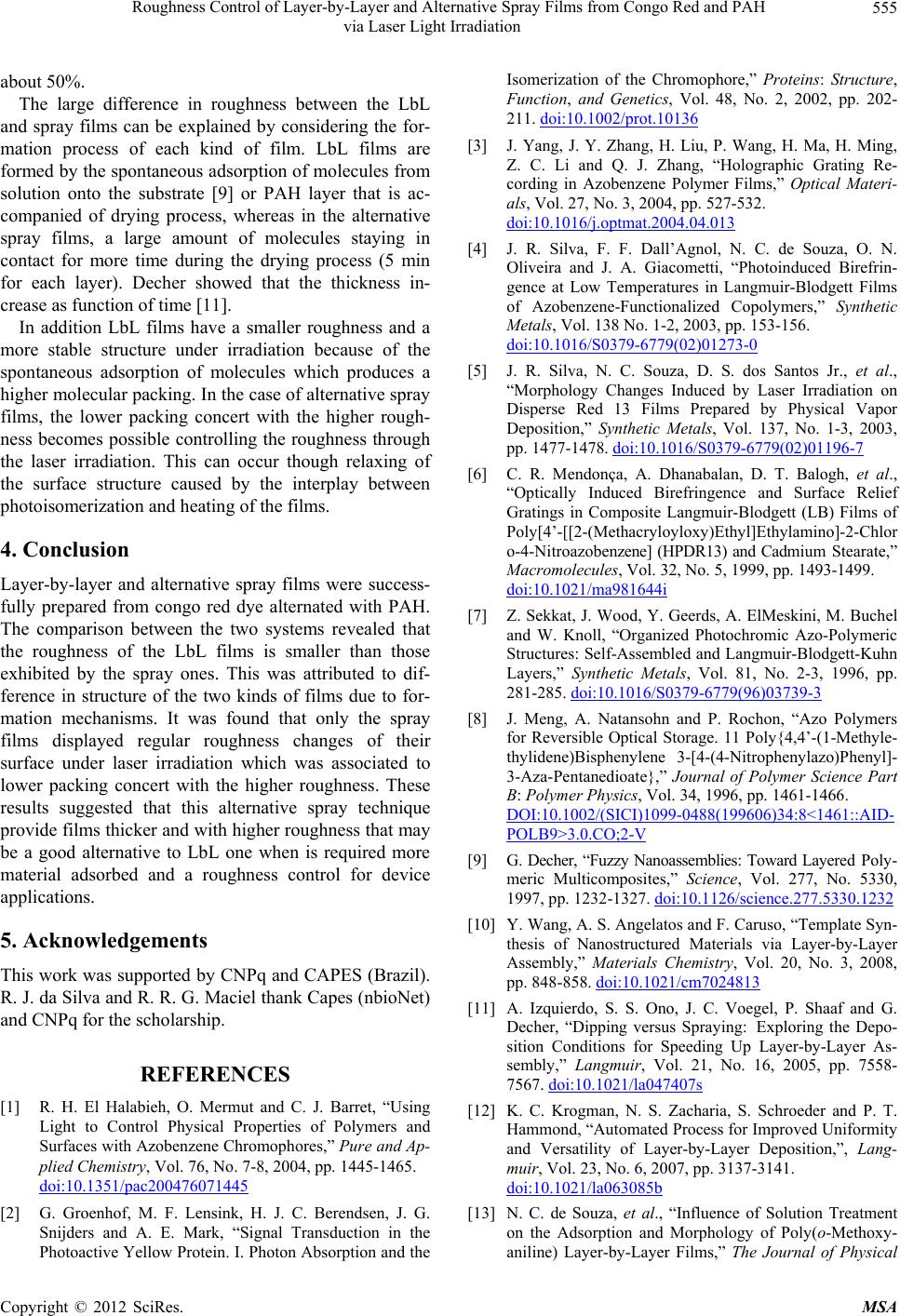
Roughness Control of Layer-by-Layer and Alternative Spray Films from Congo Red and PAH
via Laser Light Irradiation
555
about 50%.
The large difference in roughness between the LbL
and spray films can be explained by considering the for-
mation process of each kind of film. LbL films are
formed by the spontaneous adsorption of molecules from
solution onto the substrate [9] or PAH layer that is ac-
companied of drying process, whereas in the alternative
spray films, a large amount of molecules staying in
contact for more time during the drying process (5 min
for each layer). Decher showed that the thickness in-
crease as function of time [11].
In addition LbL films have a smaller roughness and a
more stable structure under irradiation because of the
spontaneous adsorption of molecules which produces a
higher molecular packing. In the case of alternative spray
films, the lower packing concert with the higher rough-
ness becomes possible controlling the roughness through
the laser irradiation. This can occur though relaxing of
the surface structure caused by the interplay between
photoisomerization and heating of the films.
4. Conclusion
Layer-by-layer and alternative spray films were success-
fully prepared from congo red dye alternated with PAH.
The comparison between the two systems revealed that
the roughness of the LbL films is smaller than those
exhibited by the spray ones. This was attributed to dif-
ference in structure of the two kinds of films due to for-
mation mechanisms. It was found that only the spray
films displayed regular roughness changes of their
surface under laser irradiation which was associated to
lower packing concert with the higher roughness. These
results suggested that this alternative spray technique
provide films thicker and with higher roughness that may
be a good alternative to LbL one when is required more
material adsorbed and a roughness control for device
applications.
5. Acknowledgements
This work was supported by CNPq and CAPES (Brazil).
R. J. da Silva and R. R. G. Maciel thank Capes (nbioNet)
and CNPq for the scholarship.
REFERENCES
[1] R. H. El Halabieh, O. Mermut and C. J. Barret, “Using
Light to Control Physical Properties of Polymers and
Surfaces with Azobenzene Chromophores,” Pure and Ap-
plied Chemistry, Vol. 76, No. 7-8, 2004, pp. 1445-1465.
doi:10.1351/pac200476071445
[2] G. Groenhof, M. F. Lensink, H. J. C. Berendsen, J. G.
Snijders and A. E. Mark, “Signal Transduction in the
Photoactive Yellow Protein. I. Photon Absorption and the
Isomerization of the Chromophore,” Proteins: Structure,
Function, and Genetics, Vol. 48, No. 2, 2002, pp. 202-
211. doi:10.1002/prot.10136
[3] J. Yang, J. Y. Zhang, H. Liu, P. Wang, H. Ma, H. Ming,
Z. C. Li and Q. J. Zhang, “Holographic Grating Re-
cording in Azobenzene Polymer Films,” Optical Materi-
als, Vol. 27, No. 3, 2004, pp. 527-532.
doi:10.1016/j.optmat.2004.04.013
[4] J. R. Silva, F. F. Dall’Agnol, N. C. de Souza, O. N.
Oliveira and J. A. Giacometti, “Photoinduced Birefrin-
gence at Low Temperatures in Langmuir-Blodgett Films
of Azobenzene-Functionalized Copolymers,” Synthetic
Metals, Vol. 138 No. 1-2, 2003, pp. 153-156.
doi:10.1016/S0379-6779(02)01273-0
[5] J. R. Silva, N. C. Souza, D. S. dos Santos Jr., et al.,
“Morphology Changes Induced by Laser Irradiation on
Disperse Red 13 Films Prepared by Physical Vapor
Deposition,” Synthetic Metals, Vol. 137, No. 1-3, 2003,
pp. 1477-1478. doi:10.1016/S0379-6779(02)01196-7
[6] C. R. Mendonça, A. Dhanabalan, D. T. Balogh, et al.,
“Optically Induced Birefringence and Surface Relief
Gratings in Composite Langmuir-Blodgett (LB) Films of
Poly[4’-[[2-(Methacryloyloxy)Ethy l]Ethylamino]-2-Chlor
o-4-Nitroazobenzene] (HPDR13) and Cadmium Stearate,”
Macromolecules, Vol. 32, No. 5, 1999, pp. 1493-1499.
doi:10.1021/ma981644i
[7] Z. Sekkat, J. Wood, Y. Geerds, A. ElMeskini, M. Buchel
and W. Knoll, “Organized Photochromic Azo-Polymeric
Structures: Self-Assembled and Langmuir-Blodgett-Kuhn
Layers,” Synthetic Metals, Vol. 81, No. 2-3, 1996, pp.
281-285. doi:10.1016/S0379-6779(96)03739-3
[8] J. Meng, A. Natansohn and P. Rochon, “Azo Polymers
for Reversible Optical Storage. 11 Poly{4,4’-(1-Methyle-
thylidene)Bisphenylene 3-[4-(4-Nitrophenylazo)Phenyl]-
3-Aza-Pentanedioate},” Journal of Polymer Science Part
B: Polymer Phys ics, Vol. 34, 1996, pp. 1461-1466.
DOI:10.1002/(SICI)1099-0488(199606)34:8<1461::AID-
POLB9>3.0.CO;2-V
[9] G. Decher, “Fuzzy Nanoassemblies: Toward Layered Poly-
meric Multicomposites,” Science, Vol. 277, No. 5330,
1997, pp. 1232-1327. doi:10.1126/science.277.5330.1232
[10] Y. Wang, A. S. Angelatos and F. Caruso, “Template Syn-
thesis of Nanostructured Materials via Layer-by-Layer
Assembly,” Materials Chemistry, Vol. 20, No. 3, 2008,
pp. 848-858. doi:10.1021/cm7024813
[11] A. Izquierdo, S. S. Ono, J. C. Voegel, P. Shaaf and G.
Decher, “Dipping versus Spraying: Exploring the Depo-
sition Conditions for Speeding Up Layer-by-Layer As-
sembly,” Langmuir, Vol. 21, No. 16, 2005, pp. 7558-
7567. doi:10.1021/la047407s
[12] K. C. Krogman, N. S. Zacharia, S. Schroeder and P. T.
Hammond, “Automated Process for Improved Uniformity
and Versatility of Layer-by-Layer Deposition,”, Lang-
muir, Vol. 23, No. 6, 2007, pp. 3137-3141.
doi:10.1021/la063085b
[13] N. C. de Souza, et al., “Influence of Solution Treatment
on the Adsorption and Morphology of Poly(o-Methoxy-
aniline) Layer-by-Layer Films,” The Journal of Physical
Copyright © 2012 SciRes. MSA